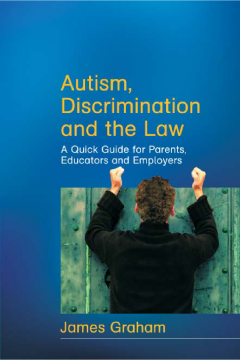
Additional Information
Book Details
Abstract
Autism, Discrimination and the Law outlines how the legal requirements of the Disability Discrimination Act 1995 might be met for students and employees with autism spectrum disorders (ASDs).
* What might discrimination against people with autism look like?
* What can you do to prevent discrimination against people with autism?
* What should you do if you have been discriminated against?
The book includes an overview of current knowledge of autism, and details of the changes in legislation concerning disability discrimination. The main part of the book is devoted to case studies from further education and employment demonstrating how reasonable adjustments can be made successfully.
This accessible book will be an essential reference for employers, policy makers, Local Education Authorities, Learning and Skills Councils, Training providers, schools and colleges, personnel officers, careers officers, charities, residential homes, parents, indeed anyone working with people with autistic spectrum disorders.
Autism, Discrimination and the Law' outlines how the legal requirements of the disabilty Discrimination Act 1995 might be met for students and employees with autism spectrum disorders (ASDs). This book is an essential reference for employers, policy makers, local education authorities, and anyone working with people with autistic spectrum disorders.
Childright
James Graham worked for many years at a senior level for the UK's National Autistic Society. He then became Principal of The INTERACT Centre, a grade one further education college in London for people with Asperger's syndrome. He is now an independent consultant and has worked and provided training and consultation for careers services, regional Learning and Skills Councils, national charities, private care homes, Local Education Authorities, social services and further education colleges. He is also a regular speaker at national conferences.
Table of Contents
| Section Title | Page | Action | Price |
|---|---|---|---|
| PART I | |||
| 2. The South African context: The double story | |||
| 3. Where we are coming from | |||
| 4. Community development effectiveness – how do we know we know? | |||
| PART II: INTENTIONS AND IDEAS | |||
| 5. Reaching for a social reconstruction tradition | |||
| 6. Reconstructing frameworks for practice | |||
| PART III: AN ASSEMBLAGE OF STORIES AND POSSIBILITIES | |||
| 7. Accompanying, horizontal learning and structuring: political practice and the Southern Cape Land Committee | |||
| 8. Action learning and research, food security and Abalimi Bezekhaya | |||
| 9. Staged place-based community development and the Hantam Community Education Trust | |||
| 10. From marginalisation to destiny: anger, violence and community protest in South Africa | |||
| 11. Informal housing and community development: A historical and human rights approach | |||
| 12. ‘Seeing like a state’ and neo-colonial cooperative development within South Africa | |||
| 13. Interlude: In dialogue with Es’kia—the decolonial turn | |||
| 14. In conclusion: Promissory reflections |
